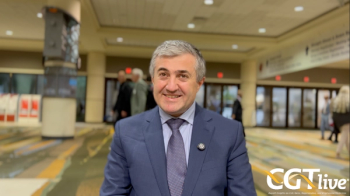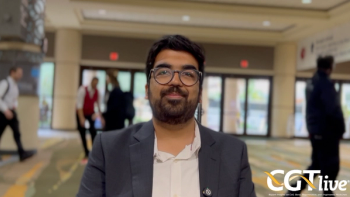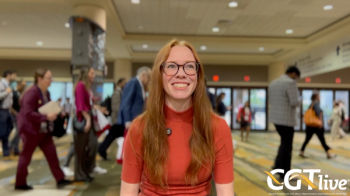
LHON Gene Therapy Continues to Show Efficacy and Safety at 3 Years Post-treatment
GenSight Biologics reported that 73% of patients treated bilaterally with Lumevoq improved at least +15 ETDRS letters relative to their worst recorded BCVA.
GenSight Biologics’
The 98 patients treated in REFLECT, all of whom had LHON associated with a mutation in the ND4 gene and vision loss up to 1 year from onset, received either bilateral treatment with Lumevoq via intravitreal injection (IVT) or unilateral treatment with Lumevoq in the first affected eye via IVT and a placebo IVT in the other eye. At 3 years post-treatment, the 48 patients who were treated bilaterally showed an improvement of +20 ETDRS letters (-0.40 LogMAR; P <.0001) in the first affected eye and an improvement of +17 ETDRS letters (-0.33 LogMAR; P <.0001) in the second affected eye. Meanwhile, among the 50 participants who received unilateral treatment, an improvement of +18 ETDRS letters (-0.36 LogMAR; P <.0001) was seen in the treated eye, while an improvement of +14 ETDRS letters (-0.28 LogMAR; P <.0001) was seen in the second affected (placebo) eye. All improvements noted were relative to the worst recorded best corrected visual acuity (BCVA) from baseline to 3 years of follow-up. The improvements seen in the placebo eye were attributed to a contralateral treatment effect. It was additionally noted that 73% of those who received bilateral treatment showed a clinically meaningful improvement of at least +15 ETDRS letters (-0.3 LogMAR) relative to their worst recorded BCVA. Furthermore, 62% of the patients who were unable to read any letters on a screen at baseline were able to read letters at 3 years of follow-up. The absolute difference in mean visual acuity between those who received bilateral treatment and those who received unilateral treatment was +6,5 ETDRS letters at 3 years post-treatment.
"The REFLECT trial has delivered a further set of results demonstrating the sustained benefit of lenadogene nolparvovec, while reconfirming its safety profile" Nancy J. Newman, MD, a professor of ophthalmology and neurology at Emory University School of Medicine and the international principal investigator of REFLECT, said in a statement regarding the news.1 "In addition, the additional benefit among bilaterally treated patients suggests that injection of both eyes may be the best option for LHON patients with the ND4 mutation."
In terms of safety, there were no serious ocular adverse events (AEs) reported. Furthermore, no patients discontinued participation in the study due to systemic or ocular AEs. Intraocular inflammation was identified as the main ocular AE, and most cases were reported to be mild and responsive to conventional treatment. It was also noted that the safety profile was comparable in patients who received bilateral and unilateral treatment.
In addition, GenSight Biologics recently published a pooled safety analysis of 189 patients treated with Lumevoq across 5 clinical trials over a 5 year period in the American Journal of Ophthalmology.2 The company noted that the data showed that systemic AEs were primarily of mild intensity and that systemic humoral and cellular immune response was limited. Furthermore, cases of ocular AEs were mostly mild and responded to conventional ophthalmologic treatments. Patients who received bilateral treatment and those who received unilateral treatment did not show significant differences in frequency and severity of systemic and ocular AEs.
“We are very pleased to see that this 3 years’ follow-up results from the REFLECT trial confirm the durable and meaningful efficacy of lenadogene nolparvovec, particularly for bilaterally treated patients,” Bernard Gilly, the chief executive officer and co-founder of GenSight Biologics, added to the statement.1 “The body of clinical evidence is making a compelling case that this gene therapy represents real hope for patients affected by this devastating blinding disease. These latest data will provide further significant support for the ongoing review of our dossier by the EMA."
GenSight Biologics announced earlier this month that a manufacturing issue has delayed the expected regulatory timeline for Lumevoq.3 The company currently anticipates a validation campaign to begin in May 2023, with the results now anticipated in the third quarter of 2023 rather than the second quarter. As such, Gensight Biologics also now anticipates an opinion from the European Committee for Medicinal Products for Human Use by the first quarter of next year. The future for Lumevoq in the United States is less certain, with the company noting its intention to resume discussions with the FDA for the purpose of establishing a regulatory pathway.
Lumevoq is not the only gene therapy in development for the treatment of LHON. Neurophth Therapeutics is developing both NR082, an investigational gene therapy intended to treat LHON associated with mutations in the ND4 gene, and NFS-02 (rAAV2-ND1), an investigational gene therapy intended to treat LHON associated with mutations in the ND1 gene.4,5 Earlier in March 2023, Neurophth reported that the phase 2/3 clinical trial (NCT04912843) evaluating NR082
REFERENCES
1. GenSight Biologics confirms sustained efficacy and safety of bilateral Lumevoq® injections at 3-year follow-up of REFLECT phase III trial. News release. GenSight Biologics. March 13, 2023. Accessed March 13, 2023. https://www.businesswire.com/news/home/20230312005028/en/
2. GenSight Biologics announces publication of Lumevoq® safety data over 5-year period in renowned peer-reviewed American Journal of Ophthalmology News release. GenSight Biologics. March 9, 2023. Accessed March 14, 2023. https://www.gensight-biologics.com/2023/03/09/gensight-biologics-announces-publication-of-lumevoq-safety-data-over-5-year-period-in-renowned-peer-reviewed-american-journal-of-ophthalmology/
3. GenSight Biologics providesupdate on Lumevoq® manufacturing and commercialization timelines. News release. GenSight Biologics. March 9, 2023. Accessed March 14, 2023. https://www.gensight-biologics.com/2023/03/07/gensight-biologics-provides-update-on-lumevoq-manufacturing-and-commercialization-timelines/
4. Commercialization of gene therapy is coming soon: Neurophth completes patient enrollment for phase iii clinical trial for the gene therapy treatment of LHON. News release. Neurophth. February 21, 2023. Accessed March 13, 2023. https://finance.yahoo.com/news/commercialization-gene-therapy-coming-soon-133000545.html
5. Neurophth receives IND clearance from FDA for AAV-ND1 gene therapy of LHON. News release. Neurophth Therapeutics, Inc. December 19, 2022. Accessed March 13, 2023. https://www.neurophth.com/en/NewsD-365.html
Newsletter
Stay at the forefront of cutting-edge science with CGT—your direct line to expert insights, breakthrough data, and real-time coverage of the latest advancements in cell and gene therapy.

















































